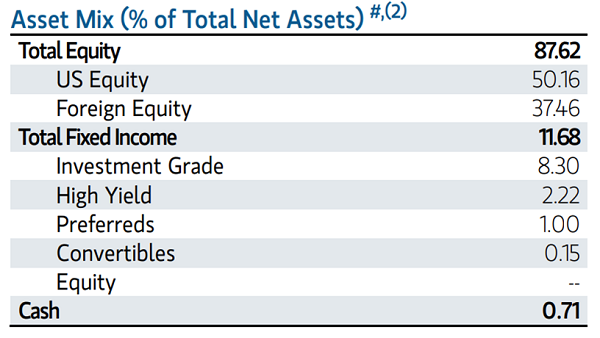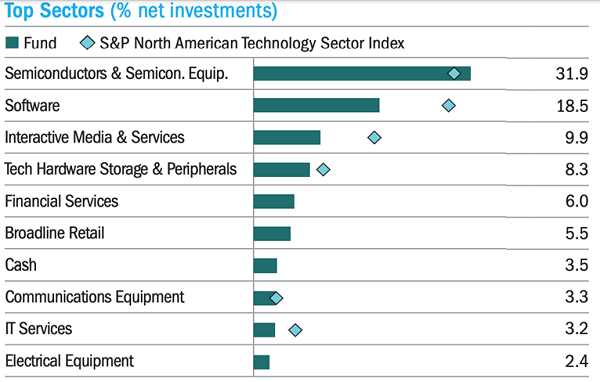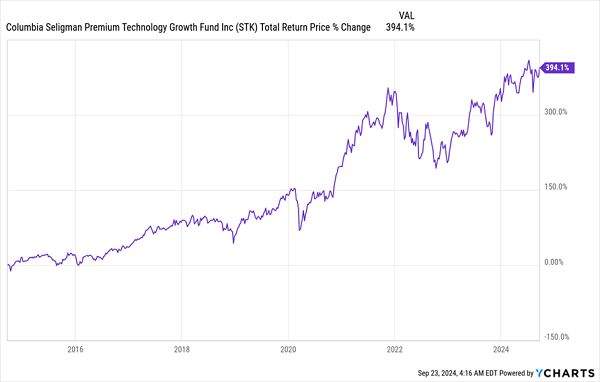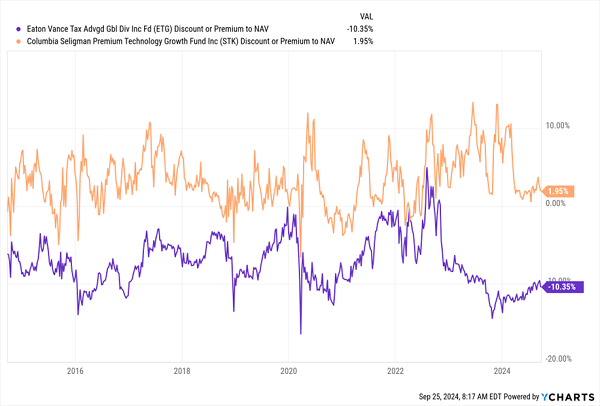Closed-end funds (CEFs), with an average yield of around 8%, are terrific for just about any investor—especially those looking to their portfolios to help pay the bills.
Heck, even if you’re not leaning on your CEFs for income, those big payouts are gold—you just reinvest them to boost your portfolio’s value and book an even bigger income stream going forward.
But of course, not all CEFs are great investments, with some best avoided unless they trade at big discounts to net asset value, or NAV, the key indicator of value for these funds. And sometimes even a great fund isn’t the best one to buy, despite a big yield and an impressive record.
That’s the situation with two CEFs that many income investors love: the Eaton Vance Tax-Advantaged Global Dividend Income Fund (ETG) and Columbia Seligman Premium Technology Growth Fund (STK).
Both have their merits, starting with their payouts: ETG yields 8.1% and STK pays a solid 5.6% as I write this. But in today’s market, one fund is clearly the better buy, and it’s all about what lies beneath those dividends.
With that in mind, let’s stack these two solid funds up and see how they compare, starting with …
Sector Exposure: The Key to Consistency
ETG makes a splash early in our matchup with a portfolio that’s incredibly well-diversified, with exposure to sectors like financials, consumer staples, energy and, yes, the sector everyone’s talking about today: tech.
The fund focuses on resilient large caps like Microsoft (MSFT), Amazon.com (AMZN), pharma giant AstraZeneca SA and Nestle SA, the latter of which is best known for sweets in North America but makes a range of foods and ingredients you’ll find in just about any kitchen.
As just those samples from the fund’s top-10 holdings list tell us, ETG also goes beyond the US, where we all know stocks have been on a tear lately, with a bit more than a third of its portfolio overseas.

Source: Eaton Vance Tax-Advantaged Global Dividend Income Fund 2Q2024 fact sheet
This level of diversification gives ETG an edge because it spreads risk across the global economy, insulating the fund from the volatility of any single sector or from another big turn in the US stock market.
And the roughly 12% of the portfolio in fixed-income investments (mainly investment-grade bonds) adds even more ballast. It helps support that big dividend, too.
Now let’s switch over to STK, whose portfolio is in many ways the opposite:

Source: Columbia Seligman Premium Technology Growth Fund June 30, 2024, fact sheet
You can clearly see that almost all of the categories in the table above are tech-related. The fund’s top holdings read like a who’s who of the tech elite and include Microsoft (MSFT), Apple (AAPL), NVIDIA (NVDA), Broadcom (AVGO) and Lam Research Corp. (LRCX).
These are all great companies, but when tech hits a rough patch, STK feels the brunt of it. NVIDIA’s price-to-earnings (P/E) ratio, which is now over 70, highlights the risk here, reflecting how pricey some of these stocks are.
When tech goes up, STK soars—but when tech stumbles, like it has recently, STK’s performance suffers. Then there’s the volatility.
Big Gains … But Big Price Swings, Too

Don’t get me wrong. STK has performed strongly over the long term, with a five-year annualized return of 17.6%. But the flipside is clear: This is a high-risk, high-reward play. That’s not ideal for income-focused investors looking for steady, reliable payouts—especially when we look at the price you’ll pay for STK now.
Discount to NAV: ETG Wins the Value Game
As I write this, ETG trades at a 10.4% discount to net asset value (NAV, or the value of its underlying portfolio), so you can buy its portfolio for quite a bit less than it’s worth.
This kind of deal is what we love to see in CEFs—it sets you up for upside and provides a margin of safety in case the market wobbles (since the fund is already cheap, it’s harder for it to get a lot cheaper).
Bargain Hunters Should Love ETG

In contrast, STK trades at a slight premium to NAV. In other words, you’re paying more for a portfolio of tech stocks that’s already trading at higher prices. With the tech sector well-known for its volatility, paying a premium doesn’t make sense, especially when we can get ETG at a discount and lock in a higher yield at the same time.
Performance and Risk: ETG’s Steady Returns vs. STK’s Rollercoaster Ride
Over the past decade, ETG has proven itself as a steady performer, delivering a 9.1% annualized return. That’s impressive, especially for a diversified income fund that’s built to withstand the market’s ups and downs.
ETG’s ability to provide consistent returns across various sectors gives it an edge when the market gets choppy. And choppiness is very much on the table after 2024’s outsized stock-market gains, especially in the tech sector.
This also means STK is like a rollercoaster just at the top of a peak. Sure, its annualized return of 17.6% over the last five years looks fantastic on paper, but that’s largely because it’s been riding the wave of tech’s explosive growth.
While STK has a portfolio perfect for those willing to ride the tech waves, ETG is simply the better buy for income investors now. Its 8.1% yield, combined with a double-digit discount to NAV and a diversified portfolio, make it a safer, more consistent play for those of us who prefer to sleep soundly at night while collecting reliable dividends.
Urgent Buy Notification: 4 CEFs That Crush ETG, Pay Massive 9.8% Dividends
With CEFs, it’s hard to underestimate how critical that discount to NAV really is. If ETG’s 10.4% discount were to return to par (where it’s been as recently as late 2022), it would add a sweet 11.5% gain to the current share price.
And that’s in addition to the 8.1% dividend!
This is the beauty of buying a discounted CEF, and I’ve got 4 more waiting for you with even bigger dividends than these two (I’m talking 9.8% yields on average here) and bigger discounts too—so big, in fact, that my research suggests 20%+ price gains from each of them over the next 12 months.
The time to buy them is now, before these outrageous discounts start to shrink! Click here to learn more and get a free Special Report revealing the names and tickers of these 4 terrific 9.8%-paying funds.
Before you make your next trade, you'll want to hear this.
MarketBeat keeps track of Wall Street's top-rated and best performing research analysts and the stocks they recommend to their clients on a daily basis.
Our team has identified the five stocks that top analysts are quietly whispering to their clients to buy now before the broader market catches on... and none of the big name stocks were on the list.
They believe these five stocks are the five best companies for investors to buy now...
See The Five Stocks Here
Which stocks are likely to thrive in today's challenging market? Enter your email address and we'll send you MarketBeat's list of ten stocks that will drive in any economic environment.
Get This Free Report